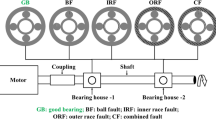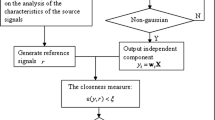Abstract
Independent component analysis (ICA) is a well known technique of blind source separation (BSS) and is used in various applications, e.g. speech, biomedical, communication, robotics, leakage detection, vibration analysis and machinery fault diagnosis. The ICA technique estimates the original source signals from the recorded multidimensional mixed signals through various sensors from any physical process. In case one or more sensor becomes faulty the separation of mixed signals becomes very difficult. In machinery, ICA is used to diagnose faults in its rotating parts that is a major concern of public safety. In case of faulty sensors, fault diagnosis becomes difficult. Moreover, in certain situations of wireless sensor networks some of the sensors fail to collect accurate information. Therefore, to collect accurate information in case of sensor failure, fault diagnosis technique is required. In this paper, a sensor fault diagnosis technique called the state observing technique (SOT) is developed to first diagnose faults in the system and then identify the faulty sensors. Also the extended sensor technique (EST) is developed to improve the separation performance of the ICA algorithm in case of faulty sensors based on information provided by the SOT technique. Effectiveness of the proposed SOT–EST technique is evaluated through extensive simulations utilizing the FastICA algorithm of ICA. To the best of our knowledge, we are the first to discuss the sensor fault diagnosis in the ICA applications.












Similar content being viewed by others
References
Guo, Y., et al. (2019). Multiple kernel independent component analysis for anti-jamming of communication radio. In IEEE international conference on signal, information and data processing (ICSIDP) (p. 2019). IEEE.
Norman-Haignere, S., Kanwisher, N. G., & McDermott, J. H. (2015). Distinct cortical pathways for music and speech revealed by hypothesis-free voxel decomposition. Neuron, 88(6), 1281–1296.
Rimmele, J. M., et al. (2015). The effects of selective attention and speech acoustics on neural speech-tracking in a multi-talker scene. Cortex, 68, 144–154.
Sompairac, N., et al. (2019). Independent component analysis for unraveling the complexity of cancer omics datasets. International Journal of Molecular Sciences, 20(18), 4414.
Chen, Y.-H., Chen, S.-W., & Wei, M.-X. (2020). A VLSI implementation of independent component analysis for biomedical signal separation using CORDIC engine. IEEE Transactions on Biomedical Circuits and Systems, 14(2), 373–381.
Chai, R., et al. (2017). Driver fatigue classification with independent component by entropy rate bound minimization analysis in an EEG-based system. IEEE Journal of Biomedical and Health Informatics, 21(3), 715–724.
Bauer, R., et al. (2015). Bridging the gap between motor imagery and motor execution with a brain–robot interface. Neuroimage, 108, 319–327.
Formaggio, E., et al. (2015). Time-frequency modulation of ERD and EEG coherence in robot-assisted hand performance. Brain Topography, 28(2), 352–363.
Wang, Z., Han, S., & Chi, N. (2020). Performance enhancement based on machine learning scheme for space multiplexing 2\(\times \)2 MIMO VLC system employing joint IQ independent component analysis. Optics Communications, 458, 124733.
Uddin, Z., et al. (2015). Independent component analysis based MIMO transceiver with improved performance in time varying wireless channels. KSII Transactions on Internet and Information Systems (TIIS), 9(7), 2435–2453.
Uddin, Z., Ahmad, A., & Iqbal, M. (2017). ICA based MIMO transceiver for time varying wireless channels utilizing smaller data blocks lengths. Wireless Personal Communications, 94(4), 3147–3161.
Uddin, Z., et al. (2016). Modified Infomax algorithm for smaller data block lengths. Springer Wireless Personal Communications, 87(1), 245–267.
Uddin, Z., et al. (2015). Applications of independent component analysis in wireless communication systems. Wireless Personal Communication, 83(4), 2711–2737.
Chen, Z., Lian, X., & Yu, Z. (2010). Leakage detection for oil pipelines based on independent component analysis. In IEEE 29th Chinese control conference (CCC), Beijing, China.
Maroua, A, et al. (2016). Design and implementation of wireless sensor network monitoring system for leak detection. In IEEE international symposium on signal, image, video and communications (ISIVC), Tunis, Tunisia (pp. 7–12).
Widodo, A., Yang, B.-S., & Han, T. (2007). Combination of independent component analysis and support vector machines for intelligent faults diagnosis of induction motors. Expert Systems with Applications, 32(2), 299–312.
Thelaidjia, T., Chenikher, S., & Moussaoui, A. (2020). Optimal wavelet analysis and enhanced independent component analysis for isolated and combined mechanical faults diagnosis. International Journal of Advanced Mechatronic Systems, 8(2–3), 116–126.
Khan, A. A., et al. (2008). A source separation technique for processing of thermometric data from fiber-optic DTS measurements for water leakage identification in dikes. IEEE Sensors Journal, 8(7), 1118–1129.
Lee, J.-M., Joe Qin, S., & Lee, I.-B. (2006). Fault detection and diagnosis based on modified independent component analysis. AIChE Journal, 52(10), 3501–3514.
Kaleem, Z., & Husain, R. M. (2018). Amateur drone monitoring: State-of-the-art architectures, key enabling technologies, and future research directions. IEEE Wireless Communications, 25, 150–159.
Zohaib, M., Kaleem, Z., & Jamalipour, A. (2019). Machine learning inspired sound-based amateur drone detection for public safety applications. IEEE Transactions on Vehicular Technology, 68, 2526–2534.
Yin, C., Nguyen, H. T., Kundu, C., Kaleem, Z., Palacios, E. G., & Duong, T. Q. (2018). Secure energy harvesting relay networks with unreliable backhaul connections. IEEE Access, 6, 12074–12084.
Kaleem, Z., & Chang, K. H. (2016). Public safety priority-based user association for load balancing and interference reduction in PS-LTE systems. IEEE Access, 4(1), 9775–9785.
Kaleem, Z., Zubair Khaliq, M., Khan, A., Ahmad, I., & Duong, T. Q. (2018). PS-CARA: Context-aware resource allocation scheme for mobile public safety networks. Sensors, 18(5), 1473.
Pöyhönen, S., Jover, P., & Hyötyniemi, H. (2003). Independent component analysis of vibrations for fault diagnosis of an induction motor. In Proceedings of IASTED international conference circuits, signals, and systems.
Christian, K., et al. (2007). On the use of time synchronous averaging, independent component analysis and support vector machines for bearing fault diagnosis. In First international conference on industrial risk engineering.
Li, Z., et al. (2013). Blind vibration component separation and nonlinear feature extraction applied to the nonstationary vibration signals for the gearbox multi-fault diagnosis. Measurement, 46(1), 259–271.
Wang, Y., et al. (2016). Spectral kurtosis for fault detection, diagnosis and prognostics of rotating machines: A review with applications. Mechanical Systems and Signal Processing, 66, 679–698.
Kang, M., et al. (2015). Reliable fault diagnosis for low-speed bearings using individually trained support vector machines with kernel discriminative feature analysis. IEEE Transactions on Power Electronics, 30(5), 2786–2797.
Yan, R., Gao, R. X., & Chen, X. (2014). Wavelets for fault diagnosis of rotary machines: A review with applications. Signal Processing, 96, 1–15.
Goumas, S. K., Zervakis, M. E., & Stavrakakis, G. S. (2002). Classification of washing machines vibration signals using discrete wavelet analysis for feature extraction. IEEE Transactions on Instrumentation and Measurement, 51(3), 497–508.
Georgoulas, G., et al. (2013). Principal component analysis of the start-up transient and hidden Markov modeling for broken rotor bar fault diagnosis in asynchronous machines. Expert Systems with Applications, 40(17), 7024–7033.
Albarbar, A., Gu, F., & Ball, A. D. (2010). Diesel engine fuel injection monitoring using acoustic measurements and independent component analysis. Measurement, 43(10), 1376–1386.
Anderson, M., Adali, T., & Li, X.-L. (2012). Joint blind source separation with multivariate Gaussian model: Algorithms and performance analysis. IEEE Transactions on Signal Processing, 60(4), 1672–1683.
Uddin, Z., et al. (2018). Adaptive step size gradient ascent ICA algorithm for wireless MIMO systems. Mobile Information Systems. https://doi.org/10.1155/2018/7038531.
Author information
Authors and Affiliations
Corresponding author
Additional information
Publisher's Note
Springer Nature remains neutral with regard to jurisdictional claims in published maps and institutional affiliations.
Rights and permissions
About this article
Cite this article
Uddin, Z., Qamar, A. & Alam, F. ICA Based Sensors Fault Diagnosis: An Audio Separation Application. Wireless Pers Commun 118, 3369–3384 (2021). https://doi.org/10.1007/s11277-021-08184-x
Accepted:
Published:
Issue Date:
DOI: https://doi.org/10.1007/s11277-021-08184-x




